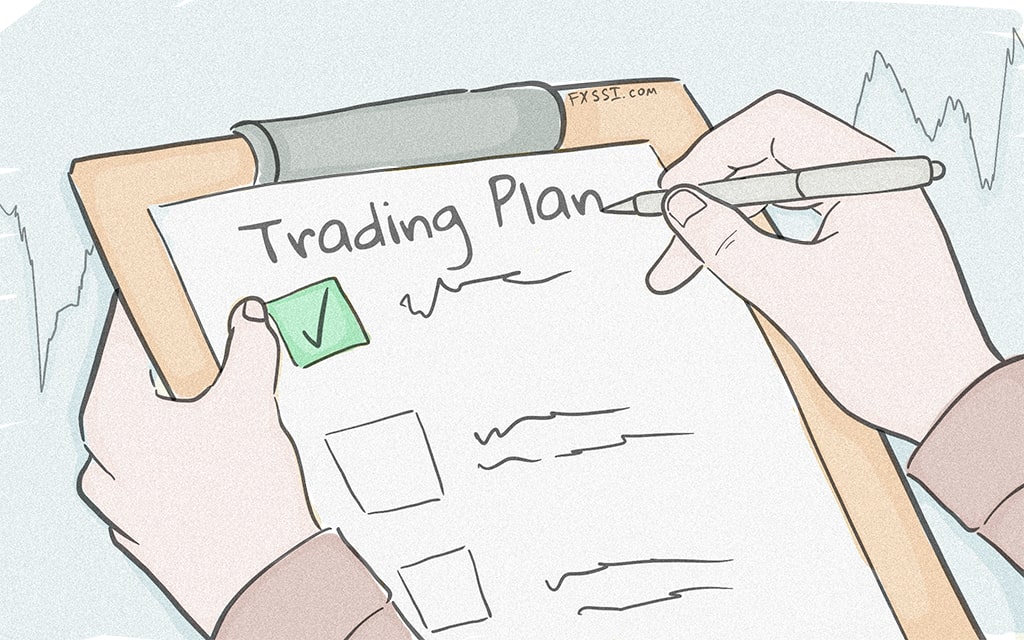The importance of a trading plan can’t be overstated, but yet the number of traders who don’t have one far outnumbers traders who do have a plan.
Without a comprehensive plan of attack it is easy to get off course. Your plan doesn’t need to be overly detailed, a few pages or so will do. But the more detailed the better. The idea here is to systematize as much of your process as possible – make them repeatable.
There are a few key components that should be included, but keep in mind there is plenty of room for flexibility for tailoring to your specific needs. As you go through and construct your plan keep this acronym in mind – K.I.S.S. (Keep It Simple Stupid).
MUST HAVE A TRADING PLAN
In anything we set out to do, if we intend on it having a shot at success, don’t we plan ahead? Some type of plan? Trading is of course not different. Markets are too dynamic, full of too much uncertainty, to try and navigate them without a solid framework in place. A plan is imperative if you are to achieve consistent trading results. They are also excellent at helping you identify your strengths and weaknesses so you can gravitate towards doing more of what works and further away from what doesn’t.
RISK MANAGEMENT
As I stress in all my webinars, proper risk management is one of, if not the most critical aspects to successful trading. Trading psychology for the discretionary trader runs with risk management in importance. Without good risk management the rest of the trading plan will not won’t matter, regardless of how good it may be. This is the very first thing you need to get straight in your plan.
You need to know your risk tolerance and adopt a risk management strategy which fits you. Know how much risk-per-trade you will take and total account risk across several positions. What is the max number of positions you will hold at once? (Fewer are easier to manage.)
Have a max drawdown figure in place as a ‘kill switch’ when things aren’t going well. For example, if you experience a drawdown of 10% you will either take a break or at least reduce your trading size. Remember, job #1 as a trader is capital preservation. (For more details, check out this session on risk management.)
ANALYTICAL APPROACH

This is straight forward – what do you use to identify set-ups? It doesn’t matter so much what you use, just that it makes sense and is used consistently. It could be some combination of price support and resistance, trend-lines/slope analysis, chart patterns, Fibonacci levels, moving averages, Elliot Wave Principle (EWP), sentiment analysis, fundamentals, etc. Perhaps all together something else. Have a process in place, is the point. In the beginning this will be difficult to outline but with time things will start to come together. Even if you have been doing this for a while, a year or two, your plan is likely to continue to change, perhaps dramatically so, as you continue to mature as a trader.
WHAT MARKETS WILL YOU FOCUS ON?
Not every market moves the same. It’s a good idea to keep your universe relatively small as it helps not only keep things simple but allows you to learn the personalities of the markets in focus. You can take it a step further and focus on specific time-frames from each market type. For example, you may trade equity indices on a very short-term time horizon (days or less), but choose to trade FX from a swing-trader standpoint (several days to several weeks). You could also have dynamic exposure to one market over another, i.e. – 75% FX, 25% indices/commodities.
TIME-FRAME, HOLD TIME
On average, what is the intended hold time for your trades? Are you a swing-trader, holding for several days to weeks using weekly/daily/4-hr charts, or do you focus on day-trading, with hold times of a few hours or less, thus using daily down to even a 1-minute chart? It could be some blend of the two.
For beginner traders interested in day trading, it is a good idea to focus on taking it slow with slower time-frames before moving towards the rapid pace of intraday trading. It’s a good idea to focus on only a couple of time-frames at most, as trying to manage trades across several time-frames can be a difficult task even for seasoned traders.
What set-ups work best for you, those that resonate with you the most? It probably goes without saying, but these should be at the core of your trading. Set-ups are based on the alignment (confluence) of any number of factors which make for a high conviction trading opportunity. If you are new to trading, then this will take some time to figure out, so be patient in making progress towards understanding what works best for you.
A set-up is one thing, but how you execute it is another. There is the set-up, then the method by which you will take advantage of the set-up. For example, a group of ten traders could sit down at a computer with the same set of tools, but how the market is analyzed and then executed upon with vary from one to another. For example, a market could be ranging and one trader will buy immediately as the market breaks out of the range while another trader who has identified the same range breakout, might wait to trade the first pullback. Or some combination of the two entry strategies.
We recommend automated trading with forex robots for beginners and professional traders.
RECOMMENDATIONS
We have created innovative HIGH GAIN PROFIT robot. We recommend our BEST ROBOT FOREXVPORTFOLIO v11, which is already being used by traders all over the world, successfully making unlimited profits over and over again.
For beginners and experienced traders!
You can WATCH LIVE STREAMING with our success forex trading here

HANDLING ADVERSITY (AND SUCCESS)
When you hit the inevitable drawdown, what will you do to make sure it doesn’t become damaging? You should reduce your trading size or stop trading altogether for a short period of time so you can alleviate stress and figure out what is going wrong. It is very important to have a plan for this before it happens.
It is also important to have a plan in place for when things are going well. Overconfidence can be a killer and lead to a drawdown if not correctly managed. While it is good to be more aggressive when market conditions are conducive and you’re doing well, but you need to do so responsibly. Increasing your risk by 50% isn’t out of control, but suddenly quadrupling your risk is, and is setting you up for a frustrating and potentially devastating outcome.
HAVE A ROUTINE FOR STAYING ON TRACK
You should set aside time to reflect on the week’s events and how you traded. It’s a good idea to regularly review your trading plan and make tweaks if necessary. Periodic review of your history and keeping a trading journal are excellent ways to ensure you are following the process outlined in your plan, as well as identifying patterns in your trading that can lead to further tweaking of your plan. Save charts of trade set-ups so you can remind yourself on a regular basis what good and bad trades look like


 Signal2forex.com - Best Forex robots and signals
Signal2forex.com - Best Forex robots and signals




